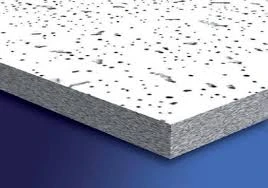Dec . 03, 2024 18:12 Back to list
difference between gypsum and pvc ceiling
The Difference Between Gypsum and PVC Ceilings
When it comes to choosing the right material for ceilings in residential and commercial spaces, gypsum and PVC (polyvinyl chloride) are two popular options. Each material has its own unique properties, advantages, and disadvantages, making them suitable for different applications. This article will explore the key differences between gypsum and PVC ceilings, helping you make an informed decision about which material best suits your needs.
Composition and Structure
Gypsum ceilings are primarily made from gypsum board, a material composed of a gypsum core sandwiched between layers of heavy paper. Gypsum is a natural mineral and is known for its fire-resistant properties. This makes gypsum ceilings an excellent choice for areas where fire safety is a concern. The boards can be finished with a smooth surface, allowing for various paint and design applications.
On the other hand, PVC ceilings are fabricated from plastic resins, which are then molded into various shapes and sizes. PVC panels are lightweight, waterproof, and resistant to mold and mildew. This makes them particularly suitable for areas with high humidity, such as kitchens and bathrooms.
Installation Process
The installation process for gypsum ceilings typically involves a more extensive effort. Gypsum boards need to be cut to size, fastened to a frame or ceiling joists, and then finished with joint compound and paint. This process can be time-consuming and may require skilled labor, especially if elaborate designs or textures are desired.
In contrast, PVC ceilings are usually simpler to install. They come in pre-fabricated panels that can be quickly attached to existing ceilings, often utilizing a clip or track system. This ease of installation can save both time and labor costs, making PVC a more cost-effective option for many homeowners and contractors.
Aesthetic Appeal
When it comes to aesthetics, both gypsum and PVC ceilings offer various design possibilities, but they appeal to different tastes. Gypsum ceilings can be finished in a multitude of ways, including painting and textured finishes. They provide a classic and elegant look, which can enhance the architectural features of a room.
difference between gypsum and pvc ceiling

PVC ceilings also come in an array of colors and designs, including wood-like textures and metallic finishes. The versatility of PVC allows it to fit seamlessly into modern and contemporary designs. However, some may view PVC as less sophisticated compared to traditional gypsum options.
Durability and Maintenance
Durability is another significant factor to consider. Gypsum ceilings are sturdy and can last for decades if properly maintained. However, they are susceptible to water damage, which can cause sagging and mold growth. In the event of a water leak, repairs can be more complicated and costly.
PVC ceilings, on the other hand, are highly durable and resistant to moisture, making them an ideal choice for bathrooms and kitchens. They do not warp, rot, or swell in humid conditions, ensuring longevity. Maintenance is also minimal, as these ceilings can be easily cleaned with soap and water.
Cost Considerations
When it comes to cost, there is a noticeable difference between gypsum and PVC ceilings. The initial cost of gypsum ceilings may be lower in terms of materials. However, due to the labor-intensive installation process, total expenses can accumulate quickly. Additionally, if water damage occurs, repair costs can further increase the financial burden.
PVC ceilings tend to be more expensive upfront per panel, but their ease of installation means that labor costs are significantly reduced. Over time, their resistance to damage and maintenance requirements can make them a more economical choice in the long run.
Conclusion
In summary, both gypsum and PVC ceilings have their merits and drawbacks, and the choice between them depends largely on your specific needs and preferences. Gypsum ceilings offer superior aesthetic appeal and fire resistance but require more labor-intensive installation and maintenance. In contrast, PVC ceilings are lightweight, moisture-resistant, and easy to install, making them more suitable for areas with high humidity. Evaluating the pros and cons of each option will help you make a well-informed decision that aligns with your project’s requirements and budget.
-
Quality Ceiling Trap Doors & Access Panels | Easy & Secure AccessNewsAug.30,2025
-
Durable Ceiling T Grid Systems | Easy InstallationNewsAug.29,2025
-
PVC Gypsum Ceiling: Durable, Laminated Tiles for Modern SpacesNewsAug.28,2025
-
Pvc Gypsum Ceiling Is DurableNewsAug.21,2025
-
Mineral Fiber Board Is DurableNewsAug.21,2025
-
Ceiling Tile Clip Reusable DesignNewsAug.21,2025







